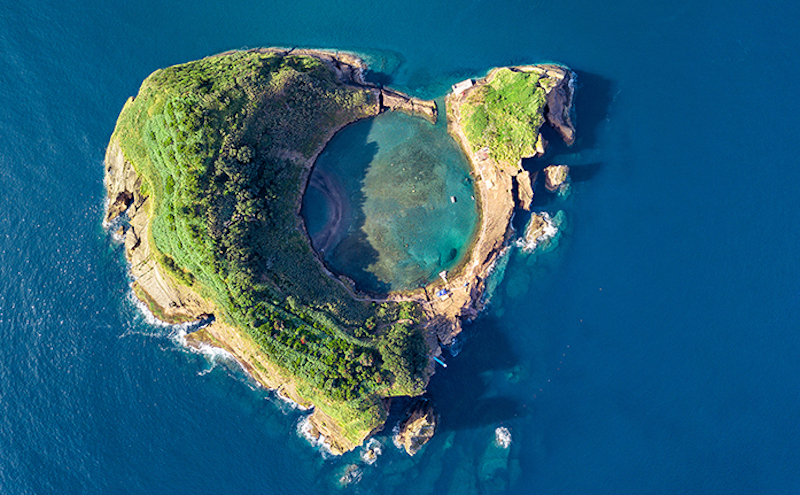

An island of the Azores: It is an example of an underwater volcano that has reached the sea surface. The crater is clearly visible. Image via aroxopt / iStock.com/ University of Würzburg
Most of the volcanic eruptions on Earth happen unseen at the bottom of the world’s oceans. In recent years, oceanography has shown that these submarine volcanoes not only deposit lava, but also eject large amounts of volcanic ash.
Bernd Zimanowski, of Julius-Maximilians-Universität in Bavaria, said in a statement:
So even under layers of water kilometers thick, which exert great pressure and thus prevent effective degassing, there must be mechanisms that lead to an ‘explosive’ disintegration of magma.
How are explosive volcanic eruptions possible deep underwater? Zimanowski is part of an international research group that has now demonstrated a mechanism for these undersea explosions. The results were published June 29, 2020 in the journal Nature Geoscience.

There are around 1,900 active volcanoes on land or as islands. The number of submarine volcanoes is estimated to be much higher. Exact numbers are not known because the deep sea is largely unexplored. Accordingly, most submarine volcanic eruptions go unnoticed. Submarine volcanoes grow slowly upwards by recurring eruptions. When they reach the water surface, they become volcanic islands – like the active Stromboli near Sicily (pictured above) or some of the Canary Islands. Image via Novinite.com
The team did research at the Havre Seamount volcano , which lies northwest of New Zealand about half a mile (1,000 meters) below the sea surface. The scientific community became aware the volcano when it erupted in 2012. The eruption created a floating carpet of pumice that expanded to about 150 square miles (400 square km), roughly the size of the city of Vienna.
For the new research, the team used a diving robot to examine the ash deposits on the seabed. From the observational data the group detected more than 100 million cubic meters of volcanic ash. The diving robot also took samples from the seafloor, which were then analyzed in the lab. Zimanowski said:
We melted the material and brought it into contact with water under various conditions. Under certain conditions, explosive reactions occurred which led to the formation of artificial volcanic ash.
The comparison of this ash with the natural samples showed that processes in the laboratory must have been similar to those that took place at a depth of 1,000 meters on the sea floor. Zimanowski added:
In the process, the molten material was placed under a layer of water in a crucible with a diameter of ten centimeters and then deformed with an intensity that can also be expected when magma emerges from the sea floor. Cracks are formed and water shoots abruptly into the vacuum created. The water then expands explosively. Finally, particles and water are ejected explosively. We lead them through an U-shaped tube into a water basin to simulate the cooling situation under water.
The particles created in this way, the “artificial volcanic ash”, corresponded in shape, size and composition to the natural ash.
The researchers believe that further investigations should also show whether underwater volcanic explosions could possibly have an effect on the climate. Zimanowski said:
With submarine lava eruptions, it takes a quite long time for the heat of the lava to be transferred to the water. In explosive eruptions, however, the magma is broken up into tiny particles. This may create heat pulses so strong that the thermal equilibrium currents in the oceans are disrupted locally or even globally.
Source: Deep-sea eruptions boosted by induced fuel–coolant explosions
Bottom line: How explosive volcanic eruptions are possible deep down in the sea.
from EarthSky https://ift.tt/2VVZpDg


An island of the Azores: It is an example of an underwater volcano that has reached the sea surface. The crater is clearly visible. Image via aroxopt / iStock.com/ University of Würzburg
Most of the volcanic eruptions on Earth happen unseen at the bottom of the world’s oceans. In recent years, oceanography has shown that these submarine volcanoes not only deposit lava, but also eject large amounts of volcanic ash.
Bernd Zimanowski, of Julius-Maximilians-Universität in Bavaria, said in a statement:
So even under layers of water kilometers thick, which exert great pressure and thus prevent effective degassing, there must be mechanisms that lead to an ‘explosive’ disintegration of magma.
How are explosive volcanic eruptions possible deep underwater? Zimanowski is part of an international research group that has now demonstrated a mechanism for these undersea explosions. The results were published June 29, 2020 in the journal Nature Geoscience.

There are around 1,900 active volcanoes on land or as islands. The number of submarine volcanoes is estimated to be much higher. Exact numbers are not known because the deep sea is largely unexplored. Accordingly, most submarine volcanic eruptions go unnoticed. Submarine volcanoes grow slowly upwards by recurring eruptions. When they reach the water surface, they become volcanic islands – like the active Stromboli near Sicily (pictured above) or some of the Canary Islands. Image via Novinite.com
The team did research at the Havre Seamount volcano , which lies northwest of New Zealand about half a mile (1,000 meters) below the sea surface. The scientific community became aware the volcano when it erupted in 2012. The eruption created a floating carpet of pumice that expanded to about 150 square miles (400 square km), roughly the size of the city of Vienna.
For the new research, the team used a diving robot to examine the ash deposits on the seabed. From the observational data the group detected more than 100 million cubic meters of volcanic ash. The diving robot also took samples from the seafloor, which were then analyzed in the lab. Zimanowski said:
We melted the material and brought it into contact with water under various conditions. Under certain conditions, explosive reactions occurred which led to the formation of artificial volcanic ash.
The comparison of this ash with the natural samples showed that processes in the laboratory must have been similar to those that took place at a depth of 1,000 meters on the sea floor. Zimanowski added:
In the process, the molten material was placed under a layer of water in a crucible with a diameter of ten centimeters and then deformed with an intensity that can also be expected when magma emerges from the sea floor. Cracks are formed and water shoots abruptly into the vacuum created. The water then expands explosively. Finally, particles and water are ejected explosively. We lead them through an U-shaped tube into a water basin to simulate the cooling situation under water.
The particles created in this way, the “artificial volcanic ash”, corresponded in shape, size and composition to the natural ash.
The researchers believe that further investigations should also show whether underwater volcanic explosions could possibly have an effect on the climate. Zimanowski said:
With submarine lava eruptions, it takes a quite long time for the heat of the lava to be transferred to the water. In explosive eruptions, however, the magma is broken up into tiny particles. This may create heat pulses so strong that the thermal equilibrium currents in the oceans are disrupted locally or even globally.
Source: Deep-sea eruptions boosted by induced fuel–coolant explosions
Bottom line: How explosive volcanic eruptions are possible deep down in the sea.
from EarthSky https://ift.tt/2VVZpDg

Aucun commentaire:
Enregistrer un commentaire